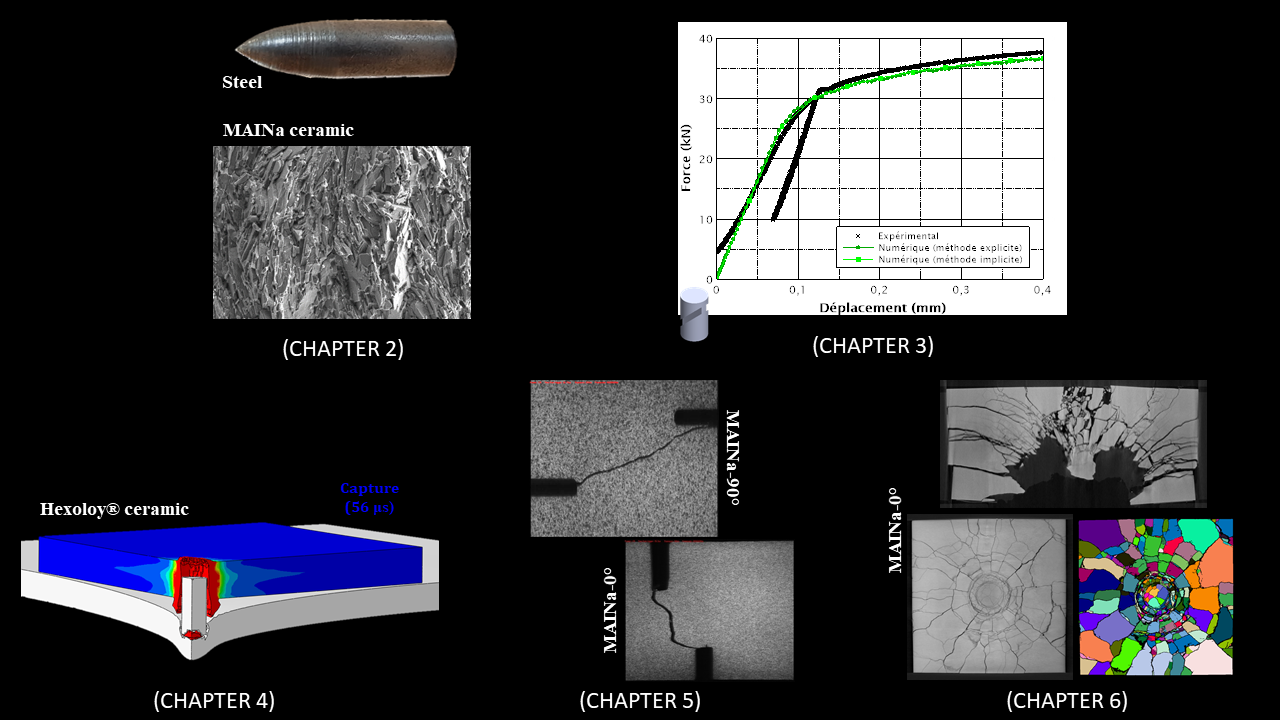- Share
- Share on Facebook
- Share on X
- Share on LinkedIn
Soutenance
On December 14, 2020
Saint-Martin-d'Hères - Domaine universitaire

Experimental characterisation and modelling of the dynamic fracture and fragmentation properties of a projectile ammunition and armour ceramics
Some ceramic grades, such as silicon carbide (SiC) or alumina (Al2O3), are used as ballistic materials thanks to their excellent mechanical performances, such as their hardness, while being light, where weight gain is a major issue for the design of military equipment for personal and vehicle protection. Since the Vietnam War, ceramics have been largely used and integrated as front face in bilayer shielding to stop the threat of AP (Armour Piercing)-type projectiles during a ballistic impact. Nevertheless, the projectile leads to an intense damage in the ceramic due to, amongst other phenomena, a dynamic tensile loading that manifests by multiple cracking, called fragmentation, particularly unfavourable for the integrity of the ballistic protection and its capacity to deal with a second impact. In order to develop a more performing shielding material, it is essential to understand the link between the microstructure of ceramics, the damage generated under impact and their ballistic performances.
This thesis seeks to better understand the dynamic fragmentation phenomenon generated at high strain rates in high fracture-toughness ceramics, including a bio-inspired alumina material mimicking nacre microstructure. This artificial nacre is, a priori, more crack resistant than conventional ceramics as it is characterised by a high static fracture-toughness due to its specific “Brick-and-Mortar” (or BM) microstructure reproduced in the material called here MAINa.
Jury
Thibaut de RESSÉGUIER, Research director, Université de Poitiers, Reviewer
Frédéric BERNARD, Professor, Université de Bourgogne, Examiner
Jean-Luc ZINSZNER, Researcher, CEA/DAM Gramat, Examiner
François BARTHÉLEMY, Engineer, DGA Techniques Terrestres, Examiner
Pascal FORQUIN, Professor, Université Grenoble Alpes, Examiner
Alexane MARGOSSIAN, R&D engineer, Saint-Gobain Research Provence, Invited
Dominique SALETTI, Assistant Professor, Université Grenoble Alpes, Invited
* Image caption
Some major results from the PhD: steel core extracted from API-BZ bullet with MAINa microstructure observed in Scanning Electron Microscopy (chapter 2); comparison between the experimental force-displacement response along with the numerical response using the identified experimental law of the steel core (chapter 3); numerical simulation of the penetration process of the steel core (800 m/s) in a SiC ceramic, 56 μs after impact (chapter 4); dynamic cracking of MAINa microstructure, tested in two orientations of platelets during Rockspall tests (chapter 5); multiple fragmentation of MAINa samples (0° orientation) after both Edge-On-Impact test in sarcophagus configuration and tandem test with tomographic segmentation (chapter 6).
Date
14h00
Localisation
Saint-Martin-d'Hères - Domaine universitaire
Kilian auditorium - ISTerre - 1381 Rue de la Piscine / 38610 / Gières



- Share
- Share on Facebook
- Share on X
- Share on LinkedIn